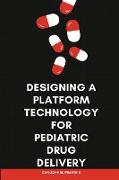- Start
- Designing a Platform Technology for Pediatric Drug Delivery
Designing a Platform Technology for Pediatric Drug Delivery
Angebote / Angebote:
The aim of present work was to utilize low temperature hot melt extrusion (HME) as a novel technology to mask bitter taste of Tenofovir DF (TDF), Furosemide (FUR) and Clarithromycin (CLR) and to develop a flexible and palatable solid oral dosage form to improve patient compliance. Pediatric patients need different oral dosage forms than adults due to differences in swallowing capabilities, taste likings, and dosage requirement. A manipulation in adult dosage form is often required to make it suitable and acceptable by pediatric patients. There are certain requirements and issues while administering existing pediatric dosage forms like requirement of dose measuring devices, chances of incorrect dosing, shaking requirement for dose accuracy in liquid dosage form and capability to administer whole quantity of formulation, chances of chewing and choking, limited dose flexibility, taste masking requirements, less stability of dosage form which instigate parents to do the manipulations. So, there is a need to develop ready to take palatable and flexible solid formulation for children through oral route which do not require manipulations while administration and must be extremely pleasant and easy to administer. Eudragit EPO used as a taste masking polymer to restrict the drug release at saliva pH and Soluplus was selected as solubilizing polymer. Plasticizers like PEG 400 and Polysorbate 80 were used to reduce glass transition temperature (Tg) of polymers and complete the HME process at lower temperature i.e. below 100°C. Solubilization capacity of Eudragit EPO and drug-excipient compatibility was performed. HME was carried out at 80°C successfully for all three drugs. Obtained taste masked granules compressed in to 8 mm round shape chewable dispersible tablets. Dissolution was carried out in Hydrochloric acid (HCL) to predict drug release in gastric environment and dissolution in pH 6.8 buffer was carried out to simulate In Vitro release with release in oral cavity as pH of the saliva is in the range from 6.3 to 7.2. Taste masking evaluation was also carried out in human volunteers. Other evaluation tests like granules characterization, saturation solubility, DSC, XRD, FTIR, friability, disintegration were also carried out. Impact of HME process on bioavailability of drugs was evaluated in animal study. Concentrations of extra-granular excipients were optimized by QbD approach with the help of DOE statistical tool.
Folgt in ca. 10 Arbeitstagen
